Building the New World – Studies in the Modern Architecture of Latin America 1930-1960
Valerie Fraser
Verso, London and New York, 2000
By Roberto Segre. Photo: Elba Gutiérrez/GuardianWitness

Throughout the twentieth century, there were consecutive waves of passionate studies by First World scholars that aimed at rescuing Latin America’s contribution to the Modern Movement. Launched in the 1930s by Alberto Sartoris –who included local works in his Encyclopédie de l’architecture moderne – those studies were continued in the catalogues edited by New York’s MOMA: Philip Goodwin’s Brazil Builds (1942), and Henry-Russell Hitchcock’s Modern Architecture in Latin America since 1945 . Later, in the 1960s, Brasilia caught the historians’ both positive and negative attention, while relevant figures were singled out, such as Venezuela’s Carlos Raúl Villanueva – studied by Sybil Moholy Nagy – and Argentina’s Clorindo Testa. In 1963, Nikolaus Pevsner asserted that the Banco de Londres y América del Sur, in Buenos Aires, was a building worthy of being included among the most relevant of the ‘First World’. When Luis Barragán was awarded in 1980 the coveted Pritzker Prize, a new wave of publications followed that divulged in Europe and the United States the Latin American production, epitomized in the contributions by Niemeyer, Legorreta, Barragán, Miguel Ángel Roca, Clorindo Testa, Ricardo Porro and Rogelio Salmona. Authors that were not traditionally associated with the region – such as Kenneth Frampton, Manfredo Tafuri, Francesco dal Co, Josep Maria Montaner – superficially approached the subject, searching for stars – or denying them – but without covering the whole firmament. So it happened with the Brazilian Paulo Mendes da Rocha, recently lit up by the Mies van der Rohe Award (2000). At the turn of the twentieth-first century, Valerie Fraser is in line with this trend of First World scholars and critics.
A daring task to make incursions into an architectural field deeply ploughed by a considerable group of local critics. The series of books and articles published by Marina Waisman, Ramón Gutiérrez, Roberto Segre, Silvia Arango, Arturo Almandoz, Francisco Liernur, Hugo Segawa, Enrique de Anda, Carlos Eduardo Comas, Antonio Toca, Humberto Eliash, Mariano Arana and others; defined theses and elaborated essential documents about the development of the modern architecture and planning in their countries. Having visited Latin America on several occasions, Fraser knew some of those works, in order to mature her personal vision about the book’s subject. Educated as an art historian in England, Fraser focused on the link between State and architecture in Mexico, Venezuela and Brazil between 1930 and 1960. She also studied the relationship with plastic arts in the ciudades universitarias (university cities) of Caracas and Mexico City, as well as on the masterpieces of Brazilian avant-garde – Rio de Janeiro’s Ministry of Health and Education (MES) and university city – through Brasilia. Although her analysis of those countries’ manifestations does not claim to deepen exhaustively into them, the author reached innovative contributions: in Mexico, she points out unknown aspects of José Vasconcelos’s relationship with architecture, while presenting an original drawing by O´Gorman (1932) –maybe an antecedent of the Pedregulho de Reidy complex – for an apartment block with common services. In Venezuela, it is shown an unpublished photograph of the pavilion by Villanueva and Luis Malaussena in the 1937 International Exhibition of Paris, while it is singled out the figure of Cipriano Domínguez, who is still scarcely known out of his country. In Brazil, the interpretation of Burle Marx’s landscape work, after his participation in Rio’s MES (1938), turns to be provocative.
Some aspects must be pointed out, though, that were not completely clarified in Fraser’s thesis. It is difficult to detach three countries from the Latin American context, without referring to the global trends during the period considered in the book. Thus for instance regarding the State’s support for significant works during the years between the wars – though they did not have “strong” governments, Argentina, Uruguay, Colombia and Chile sponsored important public buildings – as well as regarding the emergence of a “regionalist” movement after the 1960s, as a result of a search for Latin America’s national identities. Even though the author assumes as paradigms the buildings of Santiago de Chile’s CEPAL and Havana’s National Schools of Art (NSA), they represented breakthroughs in longer processes developed by several professionals in each country.
There are significant omissions in the book’s core issue –the relationship between the State and the Modern Movement and the ensuing regionalism– regarding the case studies. For Mexico, it is surprising the scarce presence of Luis Barragán, whose work summarized, both in aesthetical and conceptual terms, the search initiated by O´Gorman and the Ciudad Universitaria. In Venezuela, it would have been interesting to go in greater depth into the delicate relationship between Villanueva and the dictator Pérez Jiménez, referring to the monumental trend boosted by the government, epitomized by Luis Malaussena’s works: the Military School and the Los Próceres Promenade, contemporary of the Ciudad Universitaria.
It is difficult to understand the numerous errors regarding Brazilian architecture, considering the profusion of studies about the subject. Lucio Costa’s Razões da nova arquitetura is quoted as a1930 lecture at the National School of Fine Arts, when it was a 1934 proposal for the planning course at the University of the Federal District. As to the MES, it is not truthful, either, the assertion that “most of the materials were imported from abroad”.The structural construction and the metalwork were locally fabricated, and only the technical equipments and lights were imported. The final solution of the project is attributed to Le Corbusier, when it was elaborated by a team of Rio architects, under the aegis of Oscar Niemeyer. Corb’s outline in page 155 does not correspond to his “second proposal” at the Explanada do Castelo, but to the reproduction of the finished building. This was made after the construction of the MES, and published in the Oeuvre Complète that was so irritating for Costa and Niemeyer.
All in all, Valerie Fraser’s significant effort for interpreting some trends of Latin America’s modern architecture must be acknowledged. The above-referred flaws do not diminish the book’s aims at divulging Latin American architecture among First World scholars, usually unfamiliar with the subject. At the same time, it must be recognized that errors and omissions are excusable in studies like Fraser’s, which have the value of going from case studies into comparative perspectives. However, it must not be forgotten that the true understanding of Latin America’s complex reality can be enriched by incorporating local sources of each country. This corpus is important for art and architecture, as well as for penetrating the inscrutable plot of social, economical and cultural factors that inform Latin America’s magical and real universe.

0 comments on “Valerie Fraser: Building the New World – Studies in the Modern Architecture of Latin America 1930-1960”